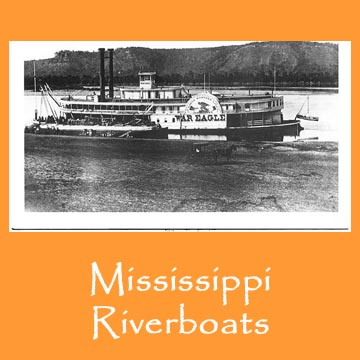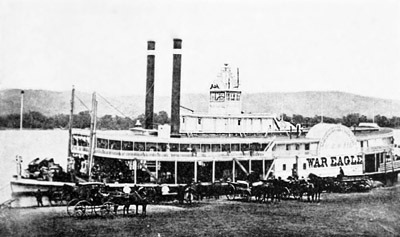As Loretta Miller Dunn’s Irish relatives left Donegal County, they settled near Burlington Vermont in 1852 before moving to the LaCresent Area of Minnesota. The Kerrigan family boarded the Lady Franklin in Galena, Illinois for passage to Minnesota. On that day the boat ran aground and they lost all their possessions.
The most common and versatile boat type on the inland rivers from the 1840s until after the Civil War was the packet. In its early English usage, “packet” referred to the carrying of mail, but these boats were all purpose vessels that carried freight and passengers, along with mail. These workhorse boats could be either stern-wheelers or side-wheelers (or occasionally center-wheelers) and had at least two decks.
Packets, which varied considerably in size and features, were the lifeblood of Upper Mississippi River trade in the mid nineteenth century. Trade was so varied and the demands of service so great that the packet steamer became the classic icon of the river.
Packets were of shallow draft, usually no more than four feet on a large boat and sometimes as little as eighteen inches on a small one, with a flexible wood hull, low-pressure condensing steam engines and a boiler or two. They had one or more cabin decks, a pilothouse, and paddle wheels on the sides or at the stern. The stern-wheeler was the most efficient design for propulsion since the driving paddles were directly behind the boat. The side-wheeler was more versatile and more easily maneuvered, as the wheels permitted the boat to turn more quickly and in a shorter space. One wheel could be reversed so that the boat could be turned almost “on a dime.” Proportionately, the packets were about six or eight times as long as they were wide.
The Lady Franklin was a side-wheel packet built at Wheeling in 1850, with a rating of 206 tons. Captain Le Grand Morehouse was in charge for the Grand Excursion. This boat operated mostly on the Upper Mississippi under a number of owners and captains. In 1855, it carried five hundred immigrant passengers on a trip from Galena to St. Paul, with a $12 fare for cabins and $6 for deck passage. It was snagged and sunk at Coon Slough below La Crosse on October 23, 1856.
In the story below, a representative of the Federal Government had taken boat north on an official tour of Minnesota and the Dakotas. He provides notes on his visit that include traveling on this boat just a month before it sunk.



